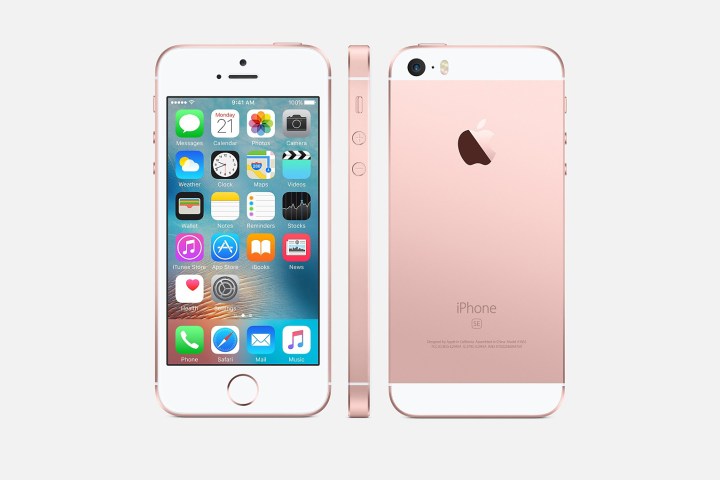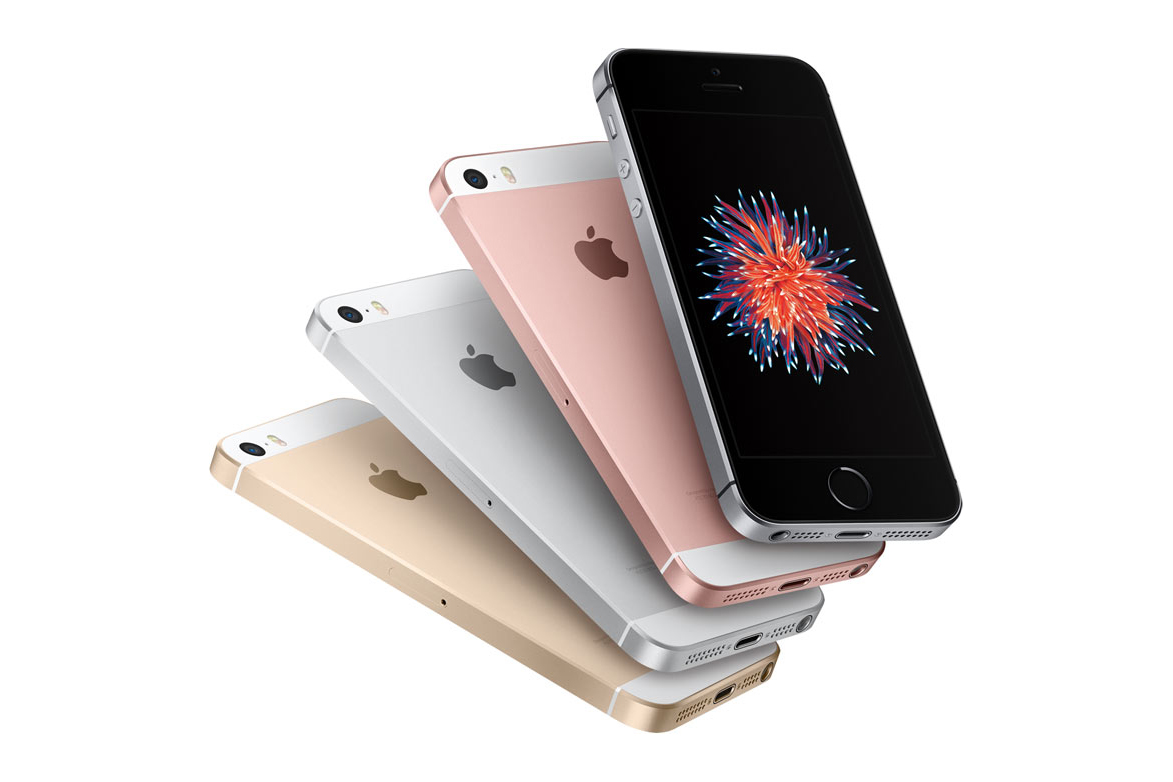
However, Apple has a number of other, larger iPhones currently on the market, so it begs the question: Just how does the new iPhone SE stack up to something like the iPhone 6S, Apple’s current flagship 4.7-inch phone? Below, we delve into that question, providing you a detailed spec breakdown, as well as analysis of how the design, power, and camera functions of the iPhone SE and iPhone 6S compare.
Apple iPhone SE |
Apple iPhone 6S |
|
| Size | 4.87 x 2.31 x .30 inches | 5.44 x 2.64 x 0.28 inches |
| Weight | 3.99 ounces | 5.04 ounces |
| Display size | 4 inches | 4.7 inches |
| Resolution | 1136 x 640 pixels | 1,334 x 750 pixels |
| OS | iOS 9.3 | iOS 9.3 |
| Capacity | 16, 64GB | 16, 64, 128GB |
| Processor | A9 chip with 64‑bit architecture, Embedded M9 motion coprocessor | A9 chip with 64-bit architecture, M9 motion coprocessor |
| RAM | 2GB | 2GB |
| Connectivity | 4G LTE, 802.11 a/b/g/n/ac, hotspot | 4G LTE, 802.11a/b/g/n/ac, NFC |
| Camera | 12 MP primary, 1.2 MP secondary | 12MP primary, 1.2MP secondary |
| Video | 4K at 30fps, 1080p at 30, 60, 0r 120fps, 720p at 240fps | 4K at 30fps, 1080p at 30 or 60fps |
| Bluetooth | 4.2 | 4.2 |
| Sensors | Fingerprint, accelerometer, gyro, proximity, compass | Touch ID fingerprint sensor, barometer, three-axis gyro, accelerometer, proximity sensor, ambient light sensor |
| Apple Pay | Yes | Yes |
| Battery | Non-removable Li-Po 1642 mAh battery | Non-removable Li-Po 1715 mAh battery |
| Charger | Lightning | Lightning |
| Marketplace | Apple App Store | Apple App Store |
| Avg. Price | $400 | $650 |
| Availability | AT&T, Verizon, Sprint, T-Mobile | AT&T, Verizon, Sprint, T-Mobile |
| Colors | Space Gray, Silver, Gold, Rose Gold | Silver, Gold, Space Gray, Rose Gold |
| DT Review | Coming Soon | 4.5/5 |
Power and Productivity
Before the official reveal of the iPhone SE, it was rumored that Apple was going to stuff the guts of an 6S into a smaller, 4-inch-screened device in order to make a phone that would appeal to 5S and 5C users who have yet to upgrade. Judging from the spec sheet for the iPhone SE, that seems to be the case.
Both the iPhone SE and the iPhone 6S use Apple’s 64-bit A9 processor, M9 motion coprocessor, and 2GB of RAM to power the phones. Since the SE has the same top-of-the-line processor and RAM as the 6S, that means both phones are truly powerful flagship devices. The two also run the latest software, iOS 9.3, which comes with Night Shift mode, password locks on Notes, and more.
That said, there are a couple differences that are worth noting. First, the battery life on the iPhone SE is slightly less than the 6S’s — 1,642mAh versus 1,715mAh, respectively. It’s a drop, but not necessarily a drastic one. The SE’s screen is also much smaller, so it should consume less energy. The other difference is that the SE doesn’t have a 128GB model like the 6S does. Instead, you’ll have to pick between the 16 and 64GB models, which are the same entry- and mid-level storage amounts on the 6S. Although 64GB is a decent size for modern phones, a 16GB limit could be restrictive, especially for users who will be taking tons of pictures and video, or downloading as many apps and games as possible.
These concessions to battery life and data storage make sense when you factor in the smaller size, but on paper, they’re still comparative shortcomings. That said, the two devices are basically identical on the inside, and given the iPhone SE’s size, it’s an impressive set of specs. Still, since the specs are the same, we’re going to call this one a tie.
Winner: Tie
Design and Display
This is where the biggest and most noteworthy gaps in numbers exist between the two phones.
The dimensions for the iPhone SE are 4.87 inches tall, 2.31 inches wide, and 0.30 inches thick. Contrast that against the iPhone 6S, which is 5.44 inches tall, 2.64 inches wide, and 0.28 inches thick. The SE measures just 0.02 inches thicker, but it’s much smaller, otherwise. In this strange future, where manufacturers seem obsessed with making their devices wider, taller, and thinner; the iPhone SE’s dimensions might appear as a misstep to some. However, Apple is pushing the SE as the replacement for the iPhone 5S and 5C, meaning it’s aiming for those who either are slow to upgrade, or who prefer smaller devices. If you happen to be a 5S or 5C user, or simply prefer smaller phones, the SE is going to be a comfortable fit.
The iPhone SE’s position as the 4-inch iPhone replacement becomes even more apparent when you look at the actual design on the phone. The SE is chunkier, with a look that is reminiscent of the iPhone 5S, it even has the classic flat sides with chamfered edges. The SE also returns the power/lock switch back to the top of the phone, as opposed to the side position on the 6S.
Mostly, these changes are cosmetic. However, the smaller size of the SE brings concessions to the size and quality of the display. iPhone 6S users enjoy a 4.7-inch 1,334 x 750-pixel HD retina display. Those who pick up the SE, on the other hand, will have a 4-inch 1,136 x 640-pixel retina display. Based on the numbers, the SE’s screen just isn’t quite as good as the 6S’s. Not only is it smaller, but the resolution and quality of the iPhone SE’s screen just aren’t up to par with the 6S’s. In this regard, the SE begins to show its true colors. It’s really just a smaller 6S, with an older iPhone design and a less-impressive screen.
In that case, we have to give this category to the 6S and its better display, though those who like small phones may beg to differ on the merits of screen size.
Winner: iPhone 6S
Interface and Accessibility
One feature absent from the iPhone SE that is present on the 6S is 3D Touch controls. The 6S ushered in a new way for iPhone users to interact with apps through pressure-sensitive control, but SE users will have no such luxury. It’s not going to hinder your user experience, though. If you’ve used virtually any Apple device — or, really, any touch device, regardless of manufacturer or OS — you’ll find the experience intuitive and familiar. However, if you’re interested in the features and interactivity that 3D Touch provides, you’ll need to opt for the 6S instead.

That’s not to say using the iPhone SE is a substandard experience, however. Smaller phones, in general, are usually a bit easier to use and handle. This is mostly due to users being able to reach their thumb across the entire phone. Apple’s devices like the 6S, and 6S Plus especially, required usability features like double tapping the home button to move on-screen apps lower for easier access when using with one hand. The iPhone SE eliminates this need, becoming the choice phone for those who prefer (or require) smaller phones.
This is a bit of a toss-up — The 6S has an expanded set of interactive features, yet the SE is easier to handle and hold. It really just comes down to your individual requirements. Want more touch controls, go with the 6S. If you prefer smaller phones, or require one due to accessibility concerns, opt for the SE. Thanks to their hardware and OS parity, outside of the specific use cases discussed in this section, using the phones will be basically identical.
Winner: Tie.
Camera
The iPhone SE and iPhone 6S sport the same chipsets and OS, and their cameras are also identical. Both devices have a 12-megapixel primary camera, both of which can capture panoramic pictures at up 63 megapixels, though the 6s runs a 5 megapixel secondary camera while SE’s is 1.2-megapixels. The video capabilities of the two phones are also impressive; Both can record in 4K at 30fps, and 1080p at 60 and 30fps.
Again, we’ve going with a tie.
Winner: Tie
Conclusion
The main takeaway here is that the SE is essentially a 6S crammed into a 4-inch body. That essentially makes the only true differences between the two iPhones their size, display, and handling. If you’ve got a 6S, there’s really no reason to move to the SE. Apple will hopefully have you covered with an iPhone 7 announcement soon, anyway. However, if you’re one of those who are slow to adoption, or who prefer smaller devices, the SE is a good choice. Apple means it when it say the iPhone SE is the most powerful 4-inch phone, and at $400, it’s at least $250 cheaper than the $650 6S, a phone of equal processing power.





